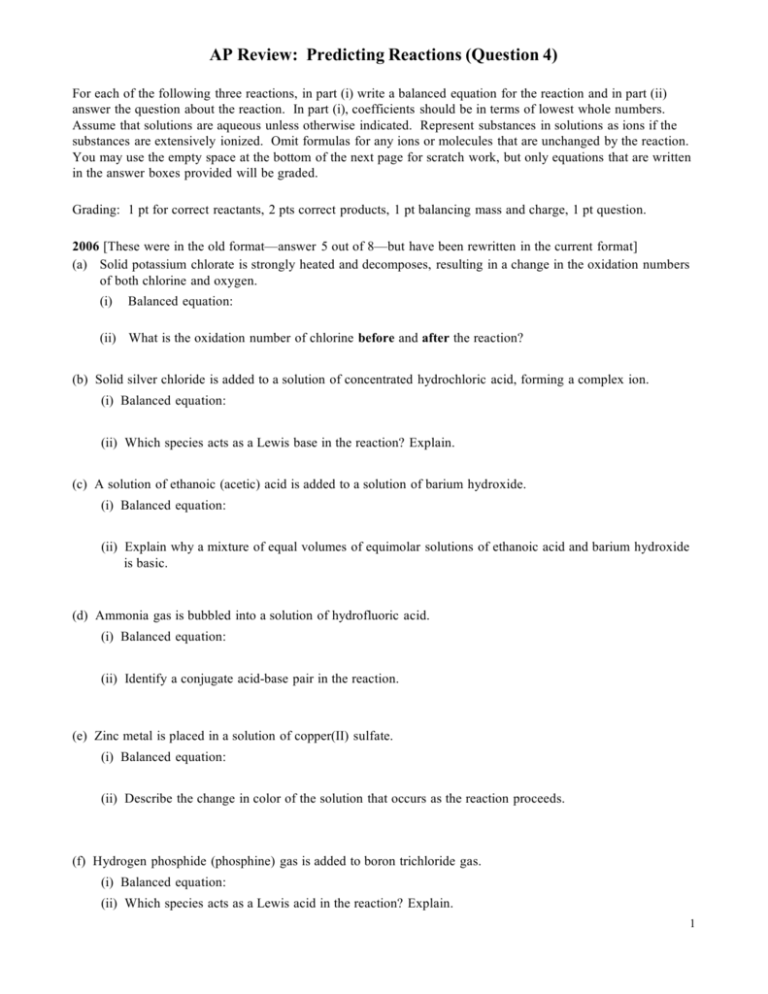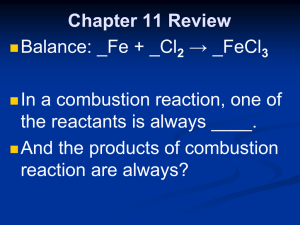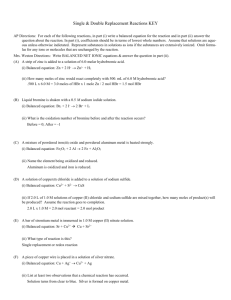AP Review: Predicting Reactions (Question 4)
advertisement

AP Review: Predicting Reactions (Question 4) For each of the following three reactions, in part (i) write a balanced equation for the reaction and in part (ii) answer the question about the reaction. In part (i), coefficients should be in terms of lowest whole numbers. Assume that solutions are aqueous unless otherwise indicated. Represent substances in solutions as ions if the substances are extensively ionized. Omit formulas for any ions or molecules that are unchanged by the reaction. You may use the empty space at the bottom of the next page for scratch work, but only equations that are written in the answer boxes provided will be graded. Grading: 1 pt for correct reactants, 2 pts correct products, 1 pt balancing mass and charge, 1 pt question. 2006 [These were in the old format—answer 5 out of 8—but have been rewritten in the current format] (a) Solid potassium chlorate is strongly heated and decomposes, resulting in a change in the oxidation numbers of both chlorine and oxygen. (i) Balanced equation: (ii) What is the oxidation number of chlorine before and after the reaction? (b) Solid silver chloride is added to a solution of concentrated hydrochloric acid, forming a complex ion. (i) Balanced equation: (ii) Which species acts as a Lewis base in the reaction? Explain. (c) A solution of ethanoic (acetic) acid is added to a solution of barium hydroxide. (i) Balanced equation: (ii) Explain why a mixture of equal volumes of equimolar solutions of ethanoic acid and barium hydroxide is basic. (d) Ammonia gas is bubbled into a solution of hydrofluoric acid. (i) Balanced equation: (ii) Identify a conjugate acid-base pair in the reaction. (e) Zinc metal is placed in a solution of copper(II) sulfate. (i) Balanced equation: (ii) Describe the change in color of the solution that occurs as the reaction proceeds. (f) Hydrogen phosphide (phosphine) gas is added to boron trichloride gas. (i) Balanced equation: (ii) Which species acts as a Lewis acid in the reaction? Explain. 1 (g) A solution of nickel(II) bromide is added to a solution of potassium hydroxide. (i) Balanced equation: (ii) Identify the spectator ions in the reaction mixture. (h) Hexane is combusted in air. (i) Balanced equation: (ii) When one molecule of hexane is completely combusted, how many molecules of products are formed? 2007 (a) A solution of sodium hydroxide is added to a solution of lead(II) nitrate. (i) Balanced equation: (ii) If 1.0 L volumes of 1.0 M solutions of sodium hydroxide and lead(II) nitrate are mixed together, how many moles of product(s) will be produced? Assume the reaction goes to completion. (b) Excess nitric acid is added to solid calcium carbonate. (i) Balanced equation: (ii) Briefly explain why statues made of marble (calcium carbonate) displayed outdoors in urban areas are deteriorating. (c) A solution containing silver(I) ion (an oxidizing agent) is mixed with a solution containing iron(II) ion (a reducing agent). (i) Balanced equation: (ii) If the contents of the reaction mixture described above are filtered, what substance(s), if any, would remain on the filter paper? 2007 Form B (a) Solid ammonium carbonate decomposes as it is heated. (i) Balanced equation: (ii) Predict the algebraic sign of ∆S˚ for the reaction. Explain your reasoning. (b) Chlorine gas, an oxidizing agent, is bubbled into a solution of potassium bromide. (i) Balanced equation: (ii) What is the oxidation number of chlorine before the reaction occurs? What is the oxidation number of chlorine after the reaction occurs? 2 (c) A small piece of sodium is placed in a beaker of distilled water. (i) Balanced equation: (ii) The reaction is exothermic, and sometimes small flames are observed as the sodium reacts with the water. Identify the product of the reaction that burns to produce the flames. Scratch Work 2008 Form B (a) Chlorine gas, an oxidizing agent, is bubbled into a solution of potassium bromide at 25°C. (i) Balanced equation: (ii) Predict the algebraic sign of ∆S˚ for the reaction. Explain your reasoning. (b) Solid strontium hydroxide is added to a solution of nitric acid. (i) Balanced equation: (ii) How many moles of strontium hydroxide would react completely with 500. mL of 0.40 M nitric acid? 3 (c) A solution of barium chloride is added drop by drop to a solution of sodium carbonate, causing a precipitate to form. (i) Balanced equation: (ii) What happens to the pH of the sodium carbonate solution as the barium chloride is added to it? 2009 (a) A sample of solid iron(III) oxide is reduced completely with solid carbon. (i) Balanced equation: (ii) What is the oxidation number of carbon before the reaction, and what is the oxidation number of carbon after the reaction is complete? (b) Equal volumes of equimolar solutions of ammonia and hydrochloric acid are combined. (i) Balanced equation: (ii) Indicate whether the resulting solution is acidic, basic, or neutral. Explain. (c) Solid mercury(II) oxide decomposes as it is heated in an open test tube in a fume hood. (i) Balanced equation: (ii) After the reaction is complete, is the mass of the material in the test tube greater than, less than, or equal to the mass of the original sample? Explain. 2009 Form B (a) A barium nitrate solution and a potassium fluoride solution are combined and a precipitate forms. (i) Balanced equation: (ii) If equimolar amounts of barium nitrate and potassium fluoride are combined, which reactant, if any, is the limiting reactant? Explain. (b) A piece of cadmium metal is oxidized by adding it to a solution of copper(II) chloride. (i) Balanced equation: (ii) List two visible changes that would occur in the reaction container as the reaction is proceeding. (c) A hydrolysis reaction occurs when solid sodium sulfide is added to distilled water. (i) Balanced equation: (ii) Indicate whether the pH of the resulting solution is less than 7, equal to 7, or greater than 7. Explain. 4 2010 (a) A 0.2 M potassium hydroxide solution is titrated with a 0.1 M nitric acid solution (i) Balanced equation: (ii) What would be observed if the solution was titrated well past the equivalence point using bromthymol blue as the indicator? (Bromothymol blue is yellow in acidic solution and blue in basic solution.) (b) Propane is burned completely in excess oxygen gas. (i) Balanced equation: (ii) When the products of the reaction are bubbled through distilled water, is the resulting solution neutral, acidic, or basic? Explain. (c) A solution of hydrogen peroxide is heated, and a gas is produced. (i) Balanced equation: (ii) Identify the oxidation state of oxygen in hydrogen peroxide. 2010 Form B (a) Solid copper(II) sulfate pentahydrate is gently heated. (i) Balanced equation: (ii) How many grams of water are present in 1.00 mol of copper(II) sulfate pentahydrate? (b) Excess concentrated aqueous ammonia is added to a solution of nickel(II) nitrate, leading to the formation of a complex ion. (i) Balanced equation: (ii) Which of the reactants acts as a Lewis acid? (c) Methylamine (CH3NH2) is added to a solution of hydrochloric acid. (i) Balanced equation: (ii) Methylamine dissolves in water to form a solution. Indicate whether this solution is acidic basic, or neutral. 5 2011 (a) Solid magnesium hydroxide is added to a solution of hydrobromic acid. (i) Balanced Equation: (ii) What volume, in mL, of 2.00 M hydrobromic acid is required to react completely with 0.10 mol of solid magnesium hydroxide? (b) Excess hydrochloric acid is added to a solution of cobalt(II) nitrate to produce a coordination complex. (i) Balanced Equation: (ii) Which species in the reaction acts as a Lewis base? (c) A copper wire is dipped into a solution of silver(I) nitrate. (i) Balanced equation: (ii) Describe what is observed as the reaction proceeds. 2011 Form B (a) Zinc metal is added to a hydrobromic acid solution. (i) Balanced equation: (ii) Write the oxidation half-reaction for the reaction. (b) Solid lithium oxide is added to distilled water (i) Balanced equation: (ii) Indicate whether the pH of the resulting solution is less than 7, equal to 7, or greater than 7. Explain. (c) A 100-mL sample of 1 M strontium chloride solution is mixed with a 100 mL sample of 1 M sodium carbonate solution, resulting in the formation of a precipirate. (i) Balanced equation: (ii) Describe what will occur if the precipitate is dried and a few drops of 1 M hydrochloric acid are added. Explain. 6







